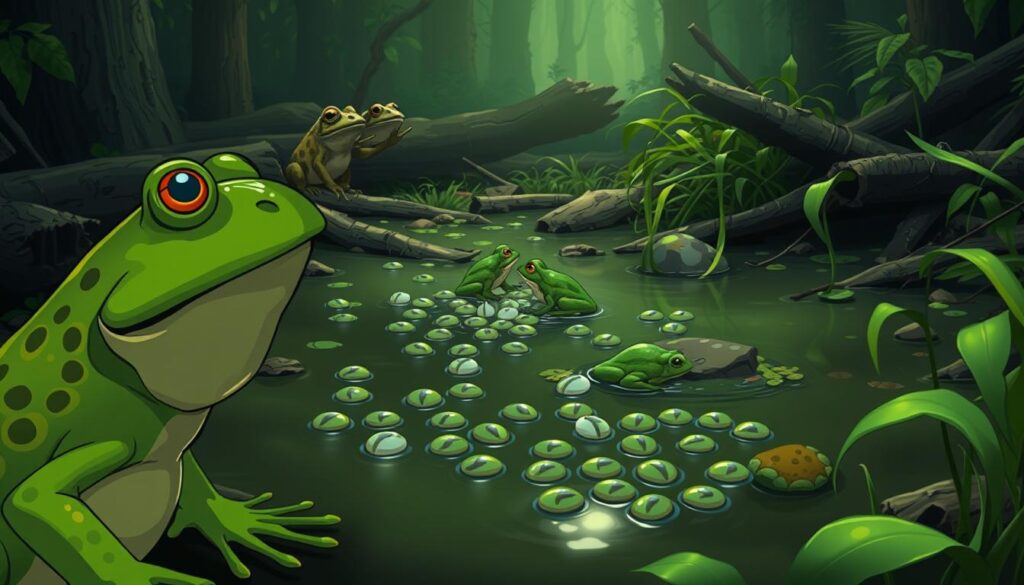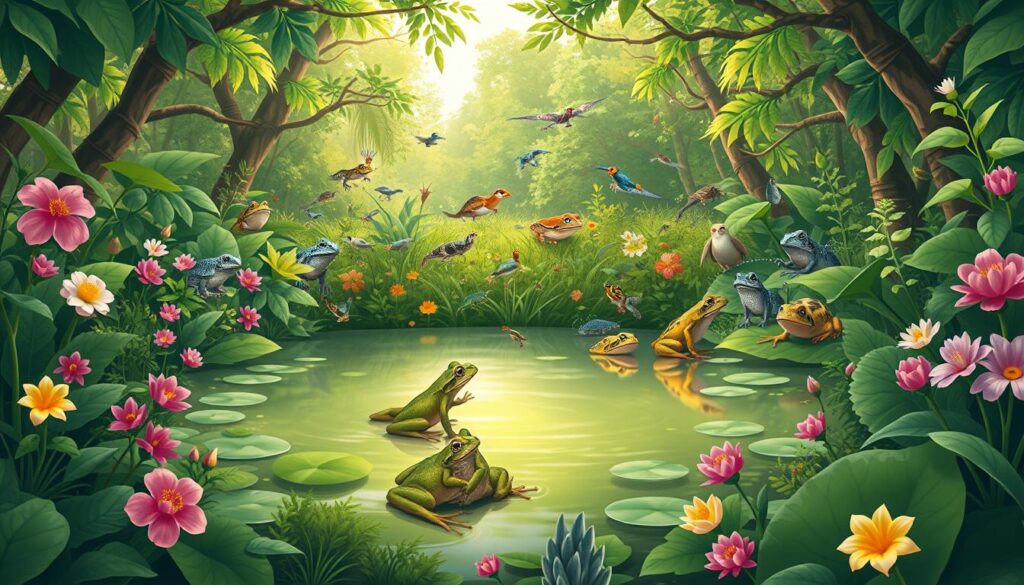Did you know that during breeding frenzies, male toads sometimes mistake human hands for potential mates? Despite these chaotic moments, nature’s resilience shines through—99% of frog eggs still get fertilized. This fascinating fact highlights both the unpredictability and the incredible adaptability of these amphibians.
Breeding frogs can be a rewarding yet complex endeavor. Urban areas, for instance, are seeing extended breeding seasons due to environmental changes, as noted by the Australian Museum’s FrogID project. However, breeders often face hurdles like maintaining the right environment and managing sex ratios to ensure successful reproduction.
By optimizing habitats and carefully monitoring conditions, enthusiasts can address these issues effectively. Whether you’re a hobbyist or a conservationist, understanding these dynamics is key to supporting the survival of various species. For more insights, check out this guide on breeding frogs at home.
Key Takeaways
- Male toads may mistakenly grab human hands during breeding frenzies.
- 99% of frog eggs get fertilized despite mating errors.
- Urban areas experience extended breeding seasons due to environmental changes.
- Optimizing habitats and managing sex ratios are crucial for success.
- Supporting species survival requires understanding breeding dynamics.
Understanding the Basics of Frog Breeding
Frog breeding is a delicate process influenced by environmental cues and timing. For many species, the right conditions are essential to ensure successful reproduction. Whether it’s the arrival of spring or the presence of water, these factors play a critical role in triggering breeding cycles.
For example, Wood Frogs in the southern U.S. begin mating in early spring, gradually migrating northward as temperatures rise. This seasonal pattern ensures that eggs are laid in optimal conditions. However, mistimed breeding can lead to significant risks, such as eggs drying out during droughts or freezing in late cold snaps.
The Importance of Timing in Frog Breeding
Timing is everything in frog breeding. Urban areas, with their artificial warmth and light, have extended breeding seasons by up to three weeks, according to the FrogID project. While this might seem beneficial, it can disrupt natural cycles and increase vulnerability to environmental changes.
“Urban heat islands create unique challenges for amphibians, altering their traditional breeding windows.”
Spring peepers, for instance, are seasonal indicators, signaling the start of breeding activities. Ensuring that breeding aligns with natural cycles is crucial for the survival of eggs and tadpoles. Permanent garden ponds can mitigate drought risks, providing a stable environment for development.
Key Environmental Factors for Successful Breeding
Several environmental factors are critical for successful frog breeding. Temperature and moisture levels are primary triggers, while food availability, such as insect populations, also plays a role. Below is a summary of these factors:
| Factor | Role in Breeding |
|---|---|
| Temperature | Triggers breeding cycles; too cold or too hot can disrupt timing. |
| Moisture | Essential for egg survival; droughts can lead to desiccation. |
| Water Sources | Permanent ponds reduce risks for eggs and tadpoles. |
| Food Availability | Insect populations support healthy development of young frogs. |
By understanding these factors, breeders can create optimal conditions for successful reproduction. Whether in urban or natural settings, aligning with nature’s rhythms is key to supporting frog species.
Common Challenges in Frog Breeding
Male frogs often face unique hurdles during their mating rituals, leading to unexpected outcomes. From mistaken identities to environmental disruptions, these challenges can impact their success. Understanding these issues is crucial for anyone interested in supporting these fascinating creatures.

Mistakes in Mate Selection
During breeding season, male frogs can be overly eager, sometimes leading to unusual choices. For example, male Wood Frogs have been known to amplex trout, dead mice, or even other males due to poor eyesight. This behavior highlights the intensity of their instinct to mate, even when it’s misdirected.
In some cases, males vastly outnumber females, creating chaotic “mating balls.” This imbalance can result in accidental cross-species pairings or wasted energy. Male frogs use release calls, or “grunts,” to deter other males, reducing unnecessary mating efforts.
Impact of Human Activity on Breeding Seasons
Urban environments are reshaping the breeding habits of frogs. Research from the FrogID project shows that 42 Australian frog species now have breeding seasons extended by up to 23 days in cities. Artificial warmth and light disrupt natural cues, leading to mistimed breeding.
Noise and light pollution further complicate matters, masking the calls males use to attract females. This can reduce mating success and leave frogs vulnerable to predators. For more insights into these frenzies, check out this guide on frog breeding frenzies.
Stress and Survival During Breeding Frenzies
Breeding season is a high-stress time for frogs. Males often stay at breeding sites for weeks, while females leave after laying eggs. This imbalance can lead to exhaustion and increased exposure to predators.
Prolonged urban breeding also poses risks. Energy depletion and failed offspring are common outcomes. By understanding these dynamics, we can better support the survival of these remarkable creatures.
Strategies to Overcome Breeding Challenges
Practical solutions backed by research can address breeding challenges effectively. By focusing on optimal environments, managing sex ratios, and minimizing human disturbance, breeders can improve outcomes for frogs and their offspring.

Creating Optimal Breeding Environments
Garden ponds with shallow edges and vegetation significantly improve egg survival. These features mimic natural wetlands, providing a stable habitat for development. Variable depths in ponds prevent egg desiccation during dry spells.
Research shows that permanent water sources reduce risks for eggs and tadpoles. Adding native plants enhances the ecosystem, offering shelter and food for young frogs. These steps ensure a healthier breeding environment.
Managing Male-to-Female Ratios
Male competition can stress breeding populations. In captivity, manually adjusting sex ratios reduces aggression and energy waste. This approach ensures that females have better mating opportunities.
Dr. Carolin Dittrich’s work highlights how female frogs avoid unwanted mates through tonic immobility and fake calls. Applying these insights can help breeders manage mating dynamics effectively.
Minimizing Human Disturbance
Urban noise and artificial lighting disrupt natural breeding cues. Installing noise barriers and reducing light pollution near breeding sites can minimize these disturbances. This helps frogs communicate and mate more successfully.
Citizen science projects like FrogID play a vital role in monitoring populations. These initiatives provide valuable data to inform conservation policies and protect breeding habitats.
| Strategy | Benefit |
|---|---|
| Constructing ponds with variable depths | Prevents egg desiccation and mimics natural wetlands |
| Adjusting sex ratios in captivity | Reduces male competition stress |
| Installing noise barriers | Minimizes disruptions from urban noise |
| Promoting citizen science projects | Provides data for informed conservation efforts |
Conclusion
Supporting frog species in urban and natural settings requires adaptive strategies and community involvement. Urban adaptation, such as creating backyard ponds, helps balance human and frog coexistence. Ongoing research, like the Australian Museum’s studies, continues to refine breeding tactics for better outcomes.
Public participation in citizen science initiatives, such as FrogID, plays a vital role in collecting large-scale data. These efforts provide valuable information to protect habitats and ensure the survival of these remarkable creatures.
Even with imperfect mating strategies, frogs have thrived for millions of years. This resilience highlights their adaptability. As spring arrives, consider visiting local wetlands to observe breeding behaviors responsibly. Together, we can make a meaningful part in conserving these essential species.
FAQ
Why is timing crucial for frog breeding?
What environmental factors are important for frog breeding?
How does mate selection affect breeding outcomes?
How does human activity impact frog breeding seasons?
What can be done to minimize stress during breeding frenzies?
How can optimal breeding environments be created?
Why is managing male-to-female ratios important?
How can human disturbance be minimized during breeding?

I’m Lena Adams—a product of an unconventional upbringing in the African wilderness. My father, a daring explorer of African wildlife, sparked my fascination with reptiles, a passion that intertwined with the tragic loss of my mother during an expedition, leaving an indelible mark on my life. Driven to understand the creatures that captivated my parents, I embarked on my journey, sharing insights about reptiles, frogs, and lizards on my website. Through my explorations and conservation efforts, I honour my family’s legacy while seeking connections—to the creatures, nature, and the mother whose presence I yearn to understand.
